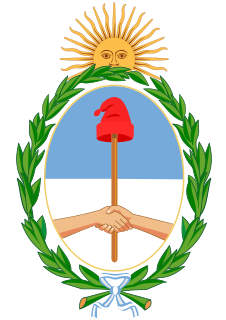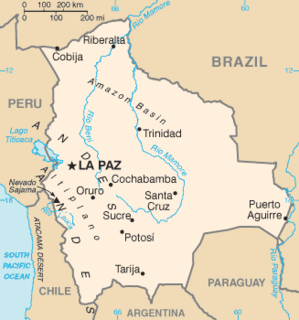Related Research Articles

Sucre is the constitutional capital of Bolivia, the capital of the Chuquisaca Department and the 6th most populated city in Bolivia. Located in the south-central part of the country, Sucre lies at an elevation of 2,810 meters. This relatively high altitude gives the city a subtropical highland climate with cool temperatures year-round.

Antonio José de Sucre y Alcalá, known as the "Gran Mariscal de Ayacucho", was a Venezuelan independence leader who served as President of Peru and as the 2nd President of Bolivia. Sucre was one of Simón Bolívar's closest friends, generals and statesmen.

The Bolivian war of independence began in 1809 with the establishment of government juntas in Sucre and La Paz, after the Chuquisaca Revolution and La Paz revolution. These Juntas were defeated shortly after, and the cities fell again under Spanish control. The May Revolution of 1810 ousted the viceroy in Buenos Aires, which established its own junta. Buenos Aires sent three large military expeditions to Upper Peru, headed by Juan José Castelli, Manuel Belgrano and José Rondeau, but the royalists ultimately prevailed over each one. However, the conflict grew into a guerrilla war, the War of the Republiquetas, preventing the royalists from strengthening their presence. After Simón Bolívar and Antonio José de Sucre defeated the royalists in northern South America, Sucre led a campaign that was to defeat the royalists in Charcas for good when the last royalist general, Pedro Antonio Olañeta, suffered death and defeat at the hands of his own defected forces at the battle of Tumusla. Bolivian independence was proclaimed on August 6 of 1825.

The Supreme Court of Justice of the Nation (Spanish: Suprema Corte de Justicia de la Nación is the Mexican institution serving as the country's federal high court and the spearhead organisation for the judiciary of the Mexican Federal Government. It consists of eleven magistrates, known as ministers of the court, one of whom is designated the court's president.

The Supreme Court of Argentina, officially known as the Supreme Court of Justice of the Argentine Nation, is the highest court of law of the Argentine Republic. It was inaugurated on 15 January 1863. However, during much of the 20th century, the Court and the Argentine judicial system in general, has lacked autonomy from the executive power. The Court has been reformed in 2003 by the decree 222/03.

The Supreme Court of Justice of Colombia in Bogotá is the highest judicial body in civil and penal matters and issues of criminal and civil procedure in Colombia. The Supreme Court of Colombia is the highest authority in regard to the interpretation of administrative law, constitutional law, and the administration of the judiciary.

Juan Nepomuceno Silva Meza, son of the writer Juan Silva Vega and professor Ana María Meza de Silva, is a Mexican jurist. He served as an Associate Justice (ministro) of the Supreme Court of Justice of the Nation since 26 January 1995, having previously served extensively elsewhere in the judiciary, including the Federal Electoral Tribunal. On 3 January 2011, he was elected Chief Justice for a term that ended on 31 December 2014.

The Roman Catholic Archdiocese of La Paz is an archdiocese located in the city of La Paz in Bolivia.

The following outline is provided as an overview of and topical guide to Bolivia:
') is the Supreme Court and Constitutional Court of Honduras. judicial authority in Honduras.

Bolivia's independence was definitively proclaimed on 6 August 1825 at a congress held in Chuquisaca.

The invasion of the Iberian Peninsula in 1807-08 by Napoleon Bonaparte's forces proved to be critical for the independence struggle in South America, during which the local elites of Upper Peru remained mostly loyal to Spain, supporting Junta Central, a government which ruled in the name of the overthrown king Ferdinand VII of Spain. A number of radical criollos in 1808-10 began a local power struggle. Pedro Domingo Murillo proclaimed an independent state in Upper Peru in the name of king Ferdinand VII. During the following seven years Upper Peru became the battleground between the armed forces of independent United Provinces of the Río de la Plata and royalist troops from Viceroyalty of Peru.

The Foreign Minister of Bolivia is the head of the Ministry of Foreign Affairs. The current minister is Rogelio Mayta, who was appointed by president Luis Arce in November 2020.
The Supreme Court of Justice is the highest court of ordinary jurisdiction in Bolivia, based in Sucre. Its powers are set out in Articles 181–185 of the 2009 Constitution and the Law of the Judicial Organ. It was first seated on 2 January 2012.

Campaign of Sucre in Upper Peru was a set of military operations conducted by the Liberator United Army of Peru to dislodge the Spanish royalists in Upper Peru or Charcas. Were started after the Battle of Ayacucho and concluded with the surrender of the last groups of realistic after combat of Tumusla.
Augusto Ibáñez Guzmán was a Colombian lawyer and academic. He was the President of the Supreme Court of Justice of Colombia from 2009–2012.
Eduardo Néstor de Lázzari was an Argentine lawyer and judge, justice president of the Supreme Court of Justice of Buenos Aires between 2004 and 2005, between 2012 and 2013, and from 24 April 2019 to 18 April 2020.

Luis Paz Arce, was a Bolivian historian, journalist, jurist, lawyer, and politician who served on the Supreme Court of Justice of Bolivia for 23 years, an associate justice from 1905 to 1919 and as the president from 1919 until his death in 1928. A conservative, Paz had a long political and academic background, serving in various legislative and ministerial positions from the early 1880s to the mid 1890s. In 1921, the National Convention selected him to be vice president under Bautista Saavedra but he rejected the position, preferring instead to remain on the High Court.

The Fourth Velasco Cabinet constituted the 16th cabinet of the Bolivian Republic. It was formed on 4 February 1848 after José Miguel de Velasco retook power in a coup d'état. It was dissolved on 16 October 1848 when José María Linares appointed a minister general charged with the dispatch of all ministerial portfolios until 6 December 1848 when Velasco was overthrown in another coup d'état.
References
- ↑ "GACETA OFICIAL DEL ESTADO PLURINACIONAL DE BOLIVIA". www.gacetaoficialdebolivia.gob.bo. Retrieved 2019-04-26.
- ↑ "The Bolivian Legal System and Legal Research - GlobaLex". www.nyulawglobal.org. Retrieved 2019-04-26.
- ↑ A Guide to the Official Publications of the Other American Republics: Haiti. 1945.
- ↑ Clagett, Helen Lord (1947). A Guide to the Law and Legal Literature of Bolivia. Library of Congress.
- ↑ Lofstrom, William Lee (1972). The promise and problem of reform: attempted social and economic change in the first years of Bolivian independence. Cornell University.
- ↑ "Los cambios en 186 años". www.opinion.com.bo. Retrieved 2019-04-26.
- ↑ "Justicia. Tras 184 años, la Corte Suprema de Bolivia cierra un ciclo con 56 presidentes". eju.tv (in Spanish). Retrieved 2019-04-26.
- ↑ Conferencia de Ministros de Justicia de Los Países Iberoamericanos (in Spanish). Ministerio de Justicia. ISBN 9788477871545.
- ↑ "La suspensión del presidente de la Corte Suprema agrava la crisis judicial de Bolivia - EcoDiario.es". ecodiario.eleconomista.es (in Spanish). 2009-05-14. Retrieved 2019-04-26.
- ↑ Doyle, Michael Scott; Fryer, T. Bruce (2018-01-01). Éxito comercial (in Spanish). Cengage Learning. ISBN 9781337670890.
- ↑ "Bolivia Judicial branch - Government". www.indexmundi.com. Retrieved 2019-04-09.
- ↑ "Bolivia". freedomhouse.org. 2018-01-04. Retrieved 2019-04-09.
